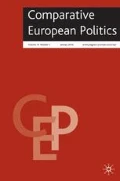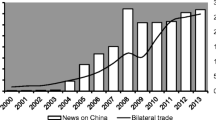Abstract
Perceptions of the United States in European public opinion greatly improved around 2008, while perceptions of China simultaneously deteriorated. The Transatlantic and Sino-European relationships stem from radically different historical contexts. Yet could the image of China and the image of the U.S. be related in the eyes of Europeans? This paper examines whether attitudes toward China have contributed to determining attitudes toward the U.S. in Europe by analyzing data from the Transatlantic Trends survey taken in 2010, a critical juncture in Europe’s relations with both the U.S. and China. We investigate three hypotheses about this relation: the “yin and yank” or negative correlation (the more Europeans fear China, the more positive they become about the U.S.; the more favorably Europeans view China, the more negatively they see the U.S.); the “open vs. closed” or positive correlation (the more favorably Europeans see China, the more favorably they see the U.S.; the more negatively they see China, the more negatively they see the U.S.); and no relation (European attitudes toward China and the U.S. are independent). To the question of whether anti-Chinese sentiment has the potential for replacing anti-Americanism in Europe, our main conclusion is that positively correlated attitudes toward the U.S. and China reveal a deep cleavage in Europe between those who are “in” and those who are “out” of globalization.
Similar content being viewed by others
References
Adler, E. and Barnett, M. (1998). Security Communities. Cambridge: Cambridge University Press.
American Political Science Association. (2009) U.S. Standing in the World: Causes, Consequences, and the Future.
Barboza, D. (2010, August 15) China Passes Japan as Second-Largest Economy. The New York Times.
BBC World Service Poll. (2011, March 27) Rising Concern about China’s Increasing Power.
BBC World Service Poll. (2011, March 7). Views of US Continue to Improve in 2011 BBC Country Rating Poll. Retrieved April 12, 2011, from http://www.worldpublicopinion.org/pipa/pdf/mar11/BBCEvalsUS_Mar11_rpt.pdf
Bradsher, K. and Dempsey, J. (2010, February) China Passes Germany as World’s Top Exporter. The New York Times.
Chiozza, G. (2009). Anti-Americanism and the American World Order. Baltimore, MD: The Johns Hopkins University Press.
European Commission. (2003, November). Globalisation. Eurobarometer 151b
Deutsch, K. W., et al (1957). Political Community and the North Atlantic Area: International Organization in the Light of Historical Experience. Princeton: Princeton University Press.
European Commission. (2008a) Eurobarometer 70.
European Commission. (2008b) Standard Eurobarometer 69.
European Commission. (2010, December 20) EU and China to debate economic and trade issues at high level dialogue. Retrieved May 6, 2011, from European Commission Trade: http://trade.ec.europa.eu/doclib/press/index.cfm?id=666&serie=391&langId=en
European Commission. (2010) Standard Eurobarometer 73.
Faiola, A. (2010) Greece is tapping China’s deep pockets to help rebuild its economy. The Washington Post.
German Marshall Fund (2010). Transatlantic Trends 2010.
Godement, F. and Parello-Plesner, J. (2011) The Scramble for Europe. European Council on Foreign Relations.
Hall, P., Jacoby, W., Levy, J. and Meunier, S. (2014). The Politics of Representation in the Global Age: Identification, Mobilization, and Adjudication. New York: Cambridge University Press.
Hanemann, T. (2014) Chinese Direct Investment in the EU and the U.S.: A Comparative View. Asia-Europe Journal 12(1): 127–142.
Hanemann, T. and Huotari, M. (2016) A New Record Year for Chinese Outbound Investment in Europe. Mercator Institute for China Studies, February 2016: http://www.merics.org/fileadmin/user_upload/downloads/COFDI_2016/A_New_Record_Year_for_Chinese_Outbound_Investment_in_Europe.pdf
Holsti, O. (2008) To See Ourselves as Others See Us: How Publics Abroad View the United States After 9/11. Ann Arbor: University of Michigan Press.
L’Express (2010) Comment la Chine Envahit l’Europe. 3109.
IFOP-La Croix. (2011) Perceptions towards globalization across ten countries.
Inman, P., Macalister, T. and Wachman, R. (2010) Ireland at forefront of Chinese plans to conquer Europe. The Guardian.
Isernia, P. (2007) Anti-Americanism in Europe during the Cold War. In P. Katzenstein and R. Keohane (Eds.), Anti-Americanisms in World Politics (pp. 57–92). Ithaca, NY: Cornell University Press.
Katzenstein, P. and Keohane, R. (2007) Anti-Americanisms in World Politics. Ithaca, NY: Cornell University Press.
Kriesi, H., et al (2012) Political Conflict in Western Europe. Cambridge: Cambridge University Press.
Meunier, S. (2013) The Dog that Did not Bark: Anti-Americanism and the 2008 Financial Crisis in Europe. Review of International Political Economy 20(1): 1–25.
Meunier, S. (2014) Beggars can’t be choosers: The European Crisis and Chinese Direct investment in the European Union. Journal of European Integration, 36(3), 283–302.
Meunier, S. (2015) A tale of two ports: The Epic Story of Chinese Direct Investment in the Greek Port of Piraeus. CritCom Forum for Research and Commentary on Europe, December 2015.
Meunier, S., Burgoon, B. and Jacoby, W. (2014) The Politics of Hosting Chinese Direct Investment in Europe. Asia-Europe Journal, 12(1), 109–126.
Moya, E. (2011) China to Make Multimillion Pound Investment in Beleaguered Spain. The Guardian.
Nyiri, Z. (2014) Public Opinion and Public Diplomacy in a Transatlantic Perspective. In S. Roy, D. Cooper and B. Murphy (eds.), Transatlantic Relations and Modern Diplomacy: An Interdisciplinary Examination. London: Routledge.
Pew Global Attitudes Project. (2010) Obama More Popular Abroad Than At Home, Global Image of U.S. Continues to Benefit. http://pewglobal.org/2010/06/17/obama-more-popular-abroad-than-at-home/.
Rodrik, D. (1997) Has Globalization Gone Too Far? Washington: Institute for International Economics.
Rodrik, D. (1998) Why do more open economies have bigger governments? Journal of Political Economy, 106(5), 997–1032.
Scheve, K. and Slaughter, M. J. (2006) Economic Insecurity and the globalization of production. In D. R. Cameron, G. Ranis and A. Zinn (eds.), Globalization and Self-Determination: Is the Nation-State Under Siege? London: Routledge.
The Economist. (2010a) Buying Up the World: The Coming Wave of Chinese Takeovers. The Economist.
The Economist. (2010b) Facing Up to China. The Economist.
The Economist. (2010c) The Dangers of a Rising China. The Economist.
Yang, Z. and Zweig, D. (2009) Does anti-Americanism correlate to pro-China sentiments? The Chinese Journal of International Politics, 2(4), 457–486.
Zakaria, F. (2008) The Post-American World. New York: W.W. Norton & Co.
Author information
Authors and Affiliations
Corresponding author
Appendix
Appendix
Methodology
Computer-Assisted Telephone Interviews (except in Poland, Slovakia, Turkey, Bulgaria, and Romania where face-to-face interviews were conducted due to the low telephone penetration rate in these five countries). The basic sample design applied in all countries was multistage random (probability). In each household, the respondent was drawn at random (following the “closest birthday rule” or Kish grid). Up to five call-backs for telephone interviews and four visits in total for face-to-face interviews were attempted before dropping a potential respondent.
The U.S. survey fieldwork was carried out by a new survey organization in 2010. This resulted in some changes in trend data due to different interviewing protocols used by the new survey organization, a phenomenon called “house effect.” Specifically, the results showed a drop in the number of “don’t know” responses. For this reason, some of the questions were asked again from a representative sample of 456 Americans between July 29, 2010 and August 4, 2010. This time, interviewers were retrained to be more in line with previous year’s protocols. For questions Q1b_1, Q11, Q25b, and Q26, the results of the new survey were reported after a careful comparison of the data from the two surveys.
For results based on the national samples in each of the 13 countries surveyed, one can say with 95% confidence that the margin of error attributable to sampling and other random effects is plus or minus three percentage points. For results based on the total European sample, the margin of error is plus or minus one percentage point. In addition to sampling error, question wording and practical difficulties in conducting surveys can also introduce error or bias into the findings of public opinion polls.
For all questions, European averages were weighted on the basis of the size of the adult population in each country to maintain consistency with previous years’ reports. For new questions, the results were also weighted so that the sample matches certain population characteristics, including age, gender, and education.
Trend Questions: 1_1, 1_2, 1b_1, 1b_2, 4, 6_1, 6_2, 7, 8a, 8b, 9, 10, 11, 13.1, 13.2, 14, 18, 22, 23, 25a, 25b, 26, 27, 32, 33.1, 33.2, 33.3, 33.4, 33.5, 36a, 38, 39
New Questions: 2.1, 2.2, 2.3, 2.4, 2.5, 3.1, 3.2, 3.3, 3.4, 3.5, 5.1, 5.2, 5.3, 5.4, 5.5, 5.6, 5.7, 8c.1, 8c.2, 8c.3, 8c.4, 12, 15, 16, 17, 19, 20, 21.1, 21.2, 21.3, 21.4, 24_1, 24_2, 28, 29, 30, 31, 34, 35, 36b
When processing is complete, data from the survey are deposited with the Inter-University Consortium for Political and Social Research at the University of Michigan (ICPSR), the Roper Center for Public Opinion Research at the University of Connecticut, and the GESIS-Leibniz Institute for the Social Sciences and are available to scholars and other interested parties (See Table A1).
Rights and permissions
About this article
Cite this article
Kim, S.Y., Meunier, S. & Nyiri, Z. Yin and yank? Public opinion in Europe toward the U.S. and China. Comp Eur Polit 15, 577–603 (2017). https://doi.org/10.1057/s41295-016-0005-6
Published:
Issue Date:
DOI: https://doi.org/10.1057/s41295-016-0005-6




